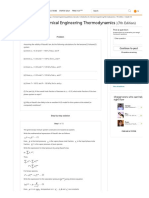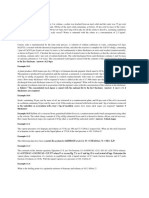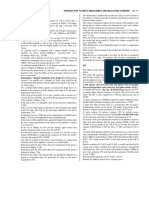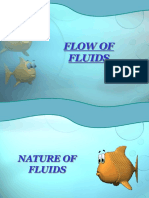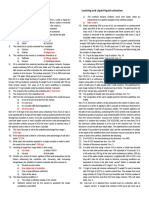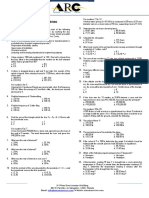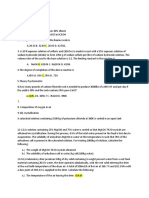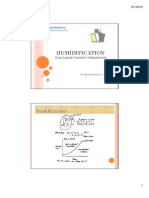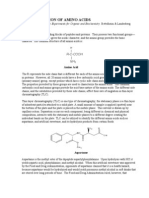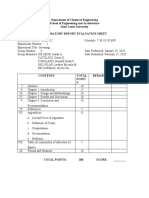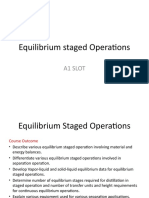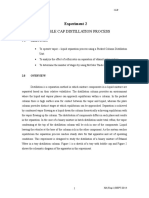Professional Documents
Culture Documents
Sepa
Sepa
Uploaded by
Robert Delfin0 ratings0% found this document useful (0 votes)
730 views2 pages1. A process involves extracting soluble solids from roasted coffee beans using water in a multistage countercurrent system. The system contains 3000 kg/h of coffee containing 24% soluble solids. 5% of solids remain in the underflow stream and 35% are in the overflow stream.
2. Cod liver oil is extracted from crushed livers using an organic solvent in a multistage countercurrent system. The feed contains 0.335 kg of oil per kg of exhausted liver. The process aims to recover 90% of the oil in the overflow stream at a composition of 60% oil.
3. Precipitated chalk is recovered from a causticizing process. Sludge containing 5% chalk
Original Description:
Copyright
© © All Rights Reserved
Available Formats
DOCX, PDF, TXT or read online from Scribd
Share this document
Did you find this document useful?
Is this content inappropriate?
Report this Document1. A process involves extracting soluble solids from roasted coffee beans using water in a multistage countercurrent system. The system contains 3000 kg/h of coffee containing 24% soluble solids. 5% of solids remain in the underflow stream and 35% are in the overflow stream.
2. Cod liver oil is extracted from crushed livers using an organic solvent in a multistage countercurrent system. The feed contains 0.335 kg of oil per kg of exhausted liver. The process aims to recover 90% of the oil in the overflow stream at a composition of 60% oil.
3. Precipitated chalk is recovered from a causticizing process. Sludge containing 5% chalk
Copyright:
© All Rights Reserved
Available Formats
Download as DOCX, PDF, TXT or read online from Scribd
Download as docx, pdf, or txt
0 ratings0% found this document useful (0 votes)
730 views2 pagesSepa
Sepa
Uploaded by
Robert Delfin1. A process involves extracting soluble solids from roasted coffee beans using water in a multistage countercurrent system. The system contains 3000 kg/h of coffee containing 24% soluble solids. 5% of solids remain in the underflow stream and 35% are in the overflow stream.
2. Cod liver oil is extracted from crushed livers using an organic solvent in a multistage countercurrent system. The feed contains 0.335 kg of oil per kg of exhausted liver. The process aims to recover 90% of the oil in the overflow stream at a composition of 60% oil.
3. Precipitated chalk is recovered from a causticizing process. Sludge containing 5% chalk
Copyright:
© All Rights Reserved
Available Formats
Download as DOCX, PDF, TXT or read online from Scribd
Download as docx, pdf, or txt
You are on page 1of 2
LEACHING 1.2 kg solution per kg of inert.
Entrainment of solids in the extract may
1. During the obtainment of soluble coffee, the soluble solids are be neglected.
extracted with water in a solid liquid extraction. This extraction is (a) The mass fraction of the solute in the extract if 90% of the solute in
performed in a multistage system that operates counter currently, the feed is to be recovered in a single stage contact is
where 3000 kg/h of roasted and ground coffee contains 24% in weight (b) The percent recovery of the solute if the extraction is carried out in
of soluble solids, while the moisture content is negligible. Five percent two crosscurrent stages if 50% of the solvent amount in problem no. 2
of the soluble solids contained in the food appear in the final underflow is used in each stage is
stream, while the overflow stream contains 35% in weight of such 10. How many stages and how much water is needed for the
solids. From the previous laboratory experiments, it was obtained that countercurrent extraction of NaOH from a feed consisting 80 lb of
the amount of solution retained by inert solids is 1.6 kg solution per kg NaOH, 400 lb water and 100 lb CaCO 3. The final extract solution will
inert solids. Calculate the number of stages needed if the global contain 10% NaOH with the recovery of 95% NaOH. We shall set the
efficiency of the system is 75%. underflow at a constant 3 lb solution per lb CaCO 3?
2. Cod liver oil is obtained from crushed livers by extraction with an 11. A multiple contact extraction is to treat 1.25 tons per hour of dry
organic solvent. A sample that contains 0.335 kg of oil per each kg of black ash containing 40% Na 2CO3 and 60% insoluble matter with 30
exhausted liver is fed into a multistage extractor that operates under gpm of water. If 5% of the Na2CO3 remains unextracted, calculate the
countercurrent, where pure organic solvent is employed. It is desired to number of ideal stages by absorption factor method. The mass ratio of
recover 90% of the oil in the final overflow, with a composition 60% in insoluble matter to solvent in the underflow from the stage is 1:2.
weight of oil. If retention of the solution is 2 kg per each 3.2 kg of 12. A mineral containing 20% elemental sulfur is to be leached with hot
insoluble solids, calculate the number of ideal stages required to carry gas oil in which sulfur is soluble to the extent of 10 parts in 100 parts of
out the desired extraction. Calculations are made assuming that 100 kg oil by weight. The oil is recycled over the over the batch of ground
of food is introduced into the extractor. mineral until no farther dissolution of sulfur takes place. On drainage,
3. It is desired to recover precipitated chalk from the causticizing of the solid minerals retain the solution to the extent of one-tenth the
soda ash. After decanting the liquor from the precipitators the sludge weight of not dissolved solid (sulfur and gangue). No preferential
has the composition 5 per cent CaCO 3, 0.1 percent NaOH and the absorption takes place. Calculate the equilibrium compositions and
balance water. 1000 Mg/day of this sludge is fed to two thickeners quantities of the solid and liquid phases if 50 kg of oil is used for
where it is washed with 200 Mg/day of neutral water. The pulp removed leaching 100 kg of fresh mineral.
from the bottom of the thickeners contains 4 kg of water/kg of chalk.
The pulp from the last thickener is taken to a rotary filter and
concentrated to 50 per cent solids and the filtrate is returned to the LIQUID-LIQUID EXTRACTION
system as wash water. Calculate the net percentage of CaCO3 in the 1. Carbon disulfide is used to extract iodine from its saturated aqueous
product after drying. solution. The distribution of iodine between carbon disulfide and water
4. Powdered limestone (CaCO3) containing 10000 ppm NaOH is to be at equilibrium may be expresses as
washed in a two-step continuous counter current washing system to K = Y*/X = 588.2
*
remove most of the NaOH. Two cells and 100000 L of water per 10 where: Y = g iodine / L of carbon disulfide
MT/day of limestone feed are used. The slurry discharged and X = g iodine /L of water
removed from the underflow contains 0.091 MT of water per MT Calculate the concentration of iodine in the aqueous phase when 1 L of
CaCO3. Assuming complete mixing and washing, calculate the NaOH a saturated solution at 20 0C containing 0.3 g of iodine per 1 L of water
content of the washed and dried limestone in ppm. is stirred with 50 ml of carbon disulfide. Repeat for two ideal extractions
5. Ten kg of a solid containing 45% of soluble material were treated using 25 ml of solvent each time.
with 15 kg of a solvent containing the same solute at 2% concentration 2. A solution that contains a valuable material M in water is recovered
in a vessel under constant agitation. After a long time, the solution and from the solution using solvent S. If 9 kg is used per kg of solution and
the solid were separated by pressing. The solid analyzed 0.8 kg of the distribution equilibrium is X/Z = 3, where X = kg M per kg water and
solvent per kg of inert solid. The extract quantity obtained in kg was Z = kg M per kg S. Calculate the % M that will remain in the solution
therefore after solvent extraction using
6. In a determination of the solution retention data, the mass fraction of (a) single batch equilibrium stage
the solute in the extract was determined to be 0.6. The corresponding (b) two successive batch equilibrium stage using fresh solvent for each
underflow analysis showed retention of 0.6 kg solvent per kg of inert step
solid. The mass fraction of solute in the underflow is most likely 3. The ratio of the solubility of stearic acid per unit volume of n-heptane
7. Barium carbonate is to be made by reacting sodium carbonate and to that in 97.5% acetic acid is 4.95. How many extractions of a 10 ml
barium sulfide. The quantities fed to the reaction agitators per 24 hours solution of stearic acid in 97.5% acetic acid with successive 10 ml
are 20 Mg of barium sulfide dissolved in 60 Mg of water, together with portions of n-heptane are needed to reduce the residual stearic acid
the theoretically necessary amount of sodium carbonate. Three content of the acetic acid layer to less than 0.5% of its original value?
thickeners in series are run on a countercurrent decantation system. 4. To plan a liquid–liquid extraction we need to know the solute’s
Overflow from the second thickener goes to the agitators, and overflow distribution ratio between the two phases. One approach is to carry out
from the first thickener is to contain 10% sodium sulfide. Sludge from the extraction on a solution containing a known amount of solute. After
all thickeners contains two parts water to one-part barium carbonate by extracting the solution, we isolate the organic phase and allow it to
mass. How much sodium sulfide will remain dried barium carbonate evaporate, leaving behind the solute. In one such experiment, 1.235 g
precipitate? of a solute with a molar mass of 117.3 g/mol is dissolved in 10.00 mL
8. Aluminum sulfate, Al2(SO4)3, is to be produced by the action of of water. After extracting with 5.00 mL of toluene, 0.889 g of the solute
sulfuric acid, H2SO4, ob bauxite in a series of agitators, with a cascade is recovered in the organic phase. How many extractions will we need
of continuous thickeners to wash the insoluble mud free of aluminum to recover 99.9% of the solute?
sulfate. 5. The distribution equilibrium for A between an extract solvent S and a
Al2O3 + 3H2SO4 Al2(SO4)3 + 3H2O raffinate solvent B is given Y=2X where Y=mass of A per unit mass of
The reaction agitators are fed with 25 tons bauxite/day, containing 50% S, X=mass of A per unit mass of B. The extract and raffinate solvents
Al2O3 and the rest insoluble; the theoretical quantity of aqueous acid are immiscible with each other at all concentrations of A. From these
containing 60% H2SO4; and the overflow from the second thickener. data, calculate the amount of extract solvent needed per 100 kg
Assume the reaction is complete. The strong product solution is to solution containing 30% A in B in 95% of A is to be removed for each of
contain 22% Al2(SO4)3, and no more than 2% of the Al2(SO4)3 produced the following arrangements:
is to be lost in the washed mud. The last thickener is to be fed with (a) Single stage contact
pure wash water. The underflow from each thickener will contain 4 kg (b) Three-stage batch contact, one third of the solvent will be used in
liquid / kg insoluble solid, and the concentration of soluble in the liquid each contact
of the underflow from each thickener may be assumed to be the same (c) Three-stage countercurrent operation
as that in the overflow. Calculate the number of thickeners required 6. (a) The solubility of iodine per unit volume is 200 times greater in
and the amount of wash water required per day. ether than in water at a particular temperature. If an aqueous solution
9. One hundred kg of a solid containing 40% solute A and 60% inert B of iodine, 30 ml in volume and containing 2 mg of iodine is shaken with
is treated with solvent C in a single stage single contact extraction. The 30 ml of ether and the ether is allowed to separate, what quantity of
extracted solids are then screw pressed. The pressed solids contain iodine remains in the water layer? (b) What quantity of iodine remains
in the water layer if only 3 ml of ether is used? (c) How much iodine is
left in the water layer if the extraction in (b) is followed by a second DISTILLATION
extraction, again using 3 ml of ether? (d) Which method is more 1. Determine the mass percentage of carbon tetrachloride (P 0 = 114.5
efficient, a single large washing or repeated small washing? torr) in the vapor phase at equilibrium in a 1:1 mole ideal solution with
trichloromethane (P0 = 199.1 torr) at 25 0C.
7. In order to extract acetic acid from dilute aqueous solution with 2. A 537 kg solution of 50% wt heptane and 50% wt octane is batch-
isopropyl ether, the two immiscible phases are passed counter distilled until only 4.74 lbmols remain in the still. Assuming α=2.0, what
currently through a packed column 3 m in length and 75 mm in will be the octane concentration of the residue by weight?
diameter. 3. Determine the relative volatility of n-butane/n-pentane mixture at
It is found that, if 0.5 kg/m2s of the pure ether is used to extract 0 .25 300C and 1 atm abs .
kg/m2s of 4.0 percent acid by mass, then the ether phase leaves the 4. One hundred mols of 15% by mole n-butane/n-pentane mixture is
column with a concentration of 1.0 percent acid by mass. distilled until the residual liquid contains 45.5 mols. Using the value of
The equilibrium relationship is given by: the relative volatility obtained in problem no. 3, find the average
(kg acid/kg isopropyl ether) = 0.3 (kg acid/kg water). concentration of the distillate in mol% butane.
Calculate: 5. A mixture of 60 mole % A and 40 mol % B is subject to flash
(a) The log mean driving force distillation at a separator pressure of 1 atm. The relative volatility of A
(b) The number of overall transfer units based on the raffinate phase with respect to B is constant 3. What fraction of the feed must be
(c) The overall extraction coefficient based on the raffinate phase vaporized to have the composition of the vapor leaving the separator
8. 30 kg benzoic acid in 100 L of water is extracted with 35 liters of be 75 mol % A?
toluene. If a 3-stage counter current extraction system is used, 6. A liquid mixture containing 55% benzene and 45% toluene by weight
calculate the weight of solute that will remain in the raffinate. The is fed to a fractionating column at a rate of 1000 kg/h. The
distribution coefficient, K is 4. concentration of benzene in the distillate and the bottoms are 92% and
9. A liquid mixture of acetaldehyde and toluene contains 8 lb of 6% by weight, respectively.
acetaldehyde and 90 lb of toluene. Part of the acetaldehyde in this (a) If the reflux ratio is 2, determine the amount of vapor in the top
solution is to be extracted using pure water as the extracting agent. section of the column.
The extraction is to be performed in two stages, using 25 lb of fresh (b) What percentage of toluene from the feed goes to the bottoms
water for each stage. The raffinate layer from the first stage is treated product?
by fresh water in the second stage. The extraction takes place at 17 0C (c) If the relative volatility between benzene and toluene is assumed to
and the equilibrium equation Y=2.2X may be employed. Assuming be constant at α = 3, what is the minimum number of stages required to
toluene and water is immiscible, what would be the weight percent of achieve the desired separation?
acetaldehyde in a mixture of the extracts from both stage if each of the 7. It is desired to produce an overhead product containing 80 mol%
extraction were theoretically perfect? benzene from a feed mixture of 68 mol% benzene and 32 mol%
10. To plan a liquid–liquid extraction we need to know the solute’s toluene. If the mixture is subjected to equilibrium distillation at 1 atm,
distribution ratio between the two phases. One approach is to carry out what is the fraction of the liquid that is vaporized?
the extraction on a solution containing a known amount of solute. After 8. Calculate the composition of the vapor in equilibrium with a liquid
extracting the solution, we isolate the organic phase and allow it to mixture of benzene, toluene, and water at 83.2 0C and absolute
evaporate, leaving behind the solute. In one such experiment, 1.235 g pressure of 1 atm. Assume that Dalton’s law applies to the benzene
of a solute with a molar mass of 117.3 g/mol is dissolved in 10.00 mL and toluene and that these compounds are insoluble in water.
of water. After extracting with 5.00 mL of toluene, 0.889 g of the solute 9. A vessel contains a liquid mixture of 50% benzene and 50% toluene
is recovered in the organic phase. How many extractions will we need by weight at 1000C. Calculate the average molecular weight of the
to recover 99.9% of the solute? vapor in contact with the solution.
11. A feed (F) containing a solute is contacted with a solvent (S) in an 10. A mixture containing 60 mol% benzene and 40 mol% toluene is fed
ideal stage shown in the diagram below. Only the soluble transfers into to a distillation column at its dew point in order to be separated into a
the solvent. The flow rates of all the streams are shown on a solute liquid distillate and a liquid bottoms product of 95 mol% and 5 mol%
free basis and indicated by the subscript S. The compositions of the benzene, respectively. The distillation is operated at a pressure P
streams are expressed on a mole ratio basis. The extract leaving the where the relative volatility can be assumed at a value of 2.48. If the
contactor is divided into two equal parts, one part is collected as the McCabe-Thiele assumptions can be applied for the system, determine
product and the other stream is recycled to join the solvent. The the reflux ratio for the infinite number of stages.
equilibrium relationship is Y*=2X.
Calculate the product flow rate ES and the composition YOUT.
12. An aqueous solution containing 1.5 kmol X / m 3 is fed at 36 ml/s to
the top of the column of height 1.60 m and cross sectional area of
0.0045 m2 and it leaves at the bottom with 1.4 kmol / m 3. An organic
solvent containing 0.006 kmol X / m 3 flows counter to the aqueous
phase at 9 ml/s. The equilibrium relationship is given by: C X organic =
0.3 CX aqueous. Calculate:
(a) The log mean concentration difference for the transfer.
(b) the overall volumetric transfer coefficient based on the organic
phase.
(c) the height of transfer unit.
You might also like
- Project-Production of AnilineDocument101 pagesProject-Production of Anilinegogana9377% (22)
- Introduction To Chemical Engineering Thermodynamics: (7th Edition)Document6 pagesIntroduction To Chemical Engineering Thermodynamics: (7th Edition)adoxa75% (4)
- ChE127 NUNEZ Assignment1Document1 pageChE127 NUNEZ Assignment1John Patrick Sanay NunezNoch keine Bewertungen
- ChE Day 1 Mock Board 2.0Document6 pagesChE Day 1 Mock Board 2.0zzrot167% (3)
- Che341 Examples BatchrDocument9 pagesChe341 Examples BatchrAybike TaşdemirNoch keine Bewertungen
- Tugas Kelompok-5 Neraca Massa Dan Energi SELF ASSEMENT TEST Page 462 Himmelblau 6 EditionDocument1 pageTugas Kelompok-5 Neraca Massa Dan Energi SELF ASSEMENT TEST Page 462 Himmelblau 6 EditionJenny AzzahraNoch keine Bewertungen
- Reviewer 1Document12 pagesReviewer 1Vanessa Denise AguilarNoch keine Bewertungen
- Coulson Sample ProblemsDocument13 pagesCoulson Sample ProblemsHayley AñonuevoNoch keine Bewertungen
- 2020-09-12 (CHECALC) Quiz 2 T3-1920 (Make-Up) PDFDocument2 pages2020-09-12 (CHECALC) Quiz 2 T3-1920 (Make-Up) PDFMarcus UyNoch keine Bewertungen
- ReviewerDocument11 pagesReviewerApril Joyce RaymundoNoch keine Bewertungen
- Chemical Engg ReviewerDocument53 pagesChemical Engg ReviewerJasonTenebroso100% (2)
- Fluid FlowDocument88 pagesFluid FlowFren R.100% (2)
- ChE ReviewerDocument27 pagesChE ReviewerJohn Paul Rodriguez100% (2)
- Liquid Liquid ExtractionDocument16 pagesLiquid Liquid ExtractionShahrizatSmailKassimNoch keine Bewertungen
- Principles of Mass Transfer and Separation ProcessesDocument1,015 pagesPrinciples of Mass Transfer and Separation ProcessesSantanu Biswas69% (26)
- LLE ReviewerDocument27 pagesLLE ReviewerConrad Monterola100% (1)
- HHHDocument2 pagesHHHquice reviewNoch keine Bewertungen
- Extraction Problem Solving DrillDocument2 pagesExtraction Problem Solving Drilledmark icalina40% (5)
- Separation ProcessesDocument3 pagesSeparation ProcessesJoshua SolomonNoch keine Bewertungen
- ACFrOgA3Jfd8opBrwGcc8dXNGVRTX7o9eO3J0cU7F7rQa5CoEWTlyrcxSHxDSq5kYkX5w1IkpyWIhSy68d9Kz J6OGnrBiBQez7ycPdUzK0wUS2DjHXc4uSzpO1H zreWLcK7hE0uG - a25pXTAkH PDFDocument2 pagesACFrOgA3Jfd8opBrwGcc8dXNGVRTX7o9eO3J0cU7F7rQa5CoEWTlyrcxSHxDSq5kYkX5w1IkpyWIhSy68d9Kz J6OGnrBiBQez7ycPdUzK0wUS2DjHXc4uSzpO1H zreWLcK7hE0uG - a25pXTAkH PDFSarah SanchezNoch keine Bewertungen
- Liquid ExtractionDocument15 pagesLiquid ExtractionravenNoch keine Bewertungen
- Single Stage Distillation: Che134P/CpmonterolaDocument40 pagesSingle Stage Distillation: Che134P/CpmonterolaConrad Monterola50% (2)
- Chapter 1 Lab ReportDocument5 pagesChapter 1 Lab ReportJabin Sta. TeresaNoch keine Bewertungen
- ChE QuestionsDocument3 pagesChE QuestionsRobert DelfinNoch keine Bewertungen
- Physical Chemistry Competency ExamDocument2 pagesPhysical Chemistry Competency ExamRaymond YabutNoch keine Bewertungen
- Sample Problem ThermoDocument25 pagesSample Problem ThermoJonnah Faye Mojares0% (1)
- Day 3Document5 pagesDay 3Robert DelfinNoch keine Bewertungen
- Final Exam CheCalc 02Document2 pagesFinal Exam CheCalc 02Christine FernandezNoch keine Bewertungen
- CHE134P FINAL EXAM 2013 14 4tDocument10 pagesCHE134P FINAL EXAM 2013 14 4tAdrian Joshua BernagaNoch keine Bewertungen
- UquirilibiumDocument30 pagesUquirilibiumAlif Alfarisyi SyahNoch keine Bewertungen
- CrystalDocument2 pagesCrystalAduchelab AdamsonuniversityNoch keine Bewertungen
- Experiment 2 Lab ReportDocument11 pagesExperiment 2 Lab ReportVanessa Denise Aguilar50% (2)
- Tutorial 1Document4 pagesTutorial 1Hanee Farzana HizaddinNoch keine Bewertungen
- Solid Fuels W:oDocument3 pagesSolid Fuels W:oShane PatulotNoch keine Bewertungen
- Process Control ProblemsDocument4 pagesProcess Control ProblemsMarco SarmientoNoch keine Bewertungen
- Checal2 LauritoDocument1 pageChecal2 LauritoGarcia RaphNoch keine Bewertungen
- Updating - MTO I - Unit 2 ProblemsDocument3 pagesUpdating - MTO I - Unit 2 ProblemsmaheshNoch keine Bewertungen
- Exam Final Preboard Chem EngDocument5 pagesExam Final Preboard Chem EngAira Jean Maningo100% (2)
- ML ML ML N ML N ML N ML N: Appendix B Calculations & ComputationsDocument14 pagesML ML ML N ML N ML N ML N: Appendix B Calculations & ComputationshaanaNoch keine Bewertungen
- 2015 NovemberDocument13 pages2015 NovemberAkiNoch keine Bewertungen
- ChoppiDocument12 pagesChoppiSarah Sanchez100% (1)
- ReviewerDocument22 pagesReviewerRobert DelfinNoch keine Bewertungen
- SEPARATIONSDocument13 pagesSEPARATIONSR ZoNoch keine Bewertungen
- Distillation: Sample ProblemsDocument7 pagesDistillation: Sample ProblemsZeny Naranjo100% (2)
- Head Losses in An Abrupt and Smoothly Contoured Change of Direction of Flow of Fluid PDFDocument30 pagesHead Losses in An Abrupt and Smoothly Contoured Change of Direction of Flow of Fluid PDFChali HaineNoch keine Bewertungen
- (AdU Special Topics) PhyChm and ChEThermo ProblemsDocument4 pages(AdU Special Topics) PhyChm and ChEThermo ProblemsRyan MartinezNoch keine Bewertungen
- EXP-2 Verification of Rayleigh Equation For Batch DistillationDocument3 pagesEXP-2 Verification of Rayleigh Equation For Batch DistillationSiddharth Mohapatra100% (2)
- Preboard Answer Key 1 PDFDocument11 pagesPreboard Answer Key 1 PDFAnonymous 0zrCNQ100% (1)
- Mccabe-Thiele MethodDocument7 pagesMccabe-Thiele MethodBlessy GabaynoNoch keine Bewertungen
- HumidificationDocument16 pagesHumidificationLiz BargolaNoch keine Bewertungen
- 3.ionic Equilibria and Biochemical ReactionsDocument4 pages3.ionic Equilibria and Biochemical ReactionsbackseeNoch keine Bewertungen
- 05-Chem Eng Tools 2016Document11 pages05-Chem Eng Tools 2016Hazel Raditya MizumareruNoch keine Bewertungen
- TLC Separation of Amino AcidsDocument5 pagesTLC Separation of Amino Acidshmtlion0% (5)
- Computer ApplicationsDocument8 pagesComputer Applicationsapi-3728602100% (1)
- 4,5,6prolem Set 2Document10 pages4,5,6prolem Set 2KeishaNoch keine Bewertungen
- Gaseous FuelsDocument5 pagesGaseous FuelsShane PatulotNoch keine Bewertungen
- Expt 1 ScreeningDocument22 pagesExpt 1 ScreeningEzekielNoch keine Bewertungen
- ChE BE Nov 2017 PDFDocument5 pagesChE BE Nov 2017 PDFJulia Gimenez100% (1)
- Sample Problem #2Document2 pagesSample Problem #2Dozdi67% (3)
- Activity 1 Calc 1 and 2 PDFDocument7 pagesActivity 1 Calc 1 and 2 PDFonyxNoch keine Bewertungen
- SepaDocument4 pagesSepaRobert DelfinNoch keine Bewertungen
- Checal ReviewerDocument8 pagesChecal ReviewerChristian Dela CruzNoch keine Bewertungen
- The Chemistry of Fertilisers and Manure - Including Information on the Chemical Constituents and Types of Fertilisers and ManuresFrom EverandThe Chemistry of Fertilisers and Manure - Including Information on the Chemical Constituents and Types of Fertilisers and ManuresRating: 5 out of 5 stars5/5 (1)
- SAlgTrig3 0P 02Document30 pagesSAlgTrig3 0P 02Robert DelfinNoch keine Bewertungen
- Course and Instructor Information: Chemical Engineering Department School Year 2017 - 2018Document11 pagesCourse and Instructor Information: Chemical Engineering Department School Year 2017 - 2018Robert DelfinNoch keine Bewertungen
- Momentum Transfer Take Home Quiz: Name: Date: Year / Section: ScoreDocument1 pageMomentum Transfer Take Home Quiz: Name: Date: Year / Section: ScoreRobert DelfinNoch keine Bewertungen
- SepaDocument4 pagesSepaRobert DelfinNoch keine Bewertungen
- Physics ARCDocument3 pagesPhysics ARCRobert DelfinNoch keine Bewertungen
- Thermo SyllabusDocument2 pagesThermo SyllabusRobert DelfinNoch keine Bewertungen
- Day 1Document18 pagesDay 1Richard RetuyaNoch keine Bewertungen
- Day 3Document5 pagesDay 3Robert DelfinNoch keine Bewertungen
- ReviewerDocument22 pagesReviewerRobert DelfinNoch keine Bewertungen
- Day 1Document18 pagesDay 1Richard RetuyaNoch keine Bewertungen
- Physics ARCDocument3 pagesPhysics ARCRobert DelfinNoch keine Bewertungen
- GATE Chemical Engineering Solved Paper 2014Document24 pagesGATE Chemical Engineering Solved Paper 2014Robert DelfinNoch keine Bewertungen
- Sugar Cane ProblemDocument1 pageSugar Cane ProblemAnonymous elDyjv7Noch keine Bewertungen
- Perrys Tabing PDFDocument6 pagesPerrys Tabing PDFcj lequinNoch keine Bewertungen
- Ejercicios de Balance de Materia PDFDocument88 pagesEjercicios de Balance de Materia PDFMichelleNoch keine Bewertungen
- Day 2 200 ItemsDocument25 pagesDay 2 200 ItemsRobert DelfinNoch keine Bewertungen
- Refresher Day 1 Part 3Document3 pagesRefresher Day 1 Part 3Robert DelfinNoch keine Bewertungen
- ChE QuestionsDocument3 pagesChE QuestionsRobert DelfinNoch keine Bewertungen
- ChE QuestionsDocument3 pagesChE QuestionsRobert DelfinNoch keine Bewertungen
- Lab ManualDocument69 pagesLab Manualtuan nguyenNoch keine Bewertungen
- Mass Transfer Operations 2020Document325 pagesMass Transfer Operations 2020EJ TanNoch keine Bewertungen
- Lesson 8 Distillation ProcessesDocument27 pagesLesson 8 Distillation ProcesseskhumisoNoch keine Bewertungen
- 7edd2 Note PDFDocument11 pages7edd2 Note PDFjeevanantham 5846Noch keine Bewertungen
- Vapour Emissions From A Solvent Waste Tank Final PDFDocument5 pagesVapour Emissions From A Solvent Waste Tank Final PDFTrường Tùng LýNoch keine Bewertungen
- Gate 1990Document12 pagesGate 1990Akhil TiwariNoch keine Bewertungen
- Random Packing Article PDFDocument88 pagesRandom Packing Article PDFAbizer Jamali100% (1)
- 10 Gas Conditioning SystemDocument24 pages10 Gas Conditioning SystemRavi Sankar VenkatesanNoch keine Bewertungen
- Fundamentals of Refining and Petrochemicals ProcessesDocument240 pagesFundamentals of Refining and Petrochemicals ProcessesMshelia M.Noch keine Bewertungen
- Size SRV For Any ConditionsDocument9 pagesSize SRV For Any ConditionsBaba JohnehNoch keine Bewertungen
- Part II Cases of Piperazine-Activated MDEA and Generic MDEADocument2 pagesPart II Cases of Piperazine-Activated MDEA and Generic MDEAShailesh LohareNoch keine Bewertungen
- Lab ManualDocument41 pagesLab ManualAman KumarNoch keine Bewertungen
- Poster EBP 2009 MMC FinalDocument2 pagesPoster EBP 2009 MMC FinalManuela CarvalhoNoch keine Bewertungen
- Power Productions Quiz - 2 Steam TableDocument4 pagesPower Productions Quiz - 2 Steam TableDar QuetzalNoch keine Bewertungen
- Depressurization of A 50 KM Long 24 Inches CO2 PipDocument11 pagesDepressurization of A 50 KM Long 24 Inches CO2 Pipharan2000Noch keine Bewertungen
- Equilibrium Staged Operations: A1 SlotDocument18 pagesEquilibrium Staged Operations: A1 SlotErmias NigussieNoch keine Bewertungen
- Equilibrium Ratio Prediction and CalculationDocument31 pagesEquilibrium Ratio Prediction and CalculationaliNoch keine Bewertungen
- Phase DiagramsDocument24 pagesPhase DiagramskkNoch keine Bewertungen
- Bubble Cap Distillation Process: Experiment 2Document13 pagesBubble Cap Distillation Process: Experiment 2Nsv DineshNoch keine Bewertungen
- Chemical Engineering - Why in A Normal Distillation Column Does Temperature and Pressure Gradient Exist From Bottom To Top - Quora PDFDocument6 pagesChemical Engineering - Why in A Normal Distillation Column Does Temperature and Pressure Gradient Exist From Bottom To Top - Quora PDFChemsys SunnyNoch keine Bewertungen
- ERT 206/4 Thermodynamics: The First Law and Other Basic ConceptsDocument31 pagesERT 206/4 Thermodynamics: The First Law and Other Basic ConceptsMuhammed FuadNoch keine Bewertungen
- Hydrocarbon Phase BehaviourDocument75 pagesHydrocarbon Phase BehaviourB. JOSEPH KWAMENoch keine Bewertungen
- Predicting Distillation Tray Efficiencies Based On Modified O'Connell Correlation Analysis (MOCA) TechniqueDocument12 pagesPredicting Distillation Tray Efficiencies Based On Modified O'Connell Correlation Analysis (MOCA) Techniquemehul10941Noch keine Bewertungen
- Performance Evaluation of A Heat Pump-Driven Vacuum Humidification-Dehumidification Desalination SystemDocument11 pagesPerformance Evaluation of A Heat Pump-Driven Vacuum Humidification-Dehumidification Desalination SystemGiovany MicuncoNoch keine Bewertungen
- IR2 ICTUAnnexure Documentof Risk AssessmentDocument45 pagesIR2 ICTUAnnexure Documentof Risk Assessmentenvironment GSNoch keine Bewertungen

